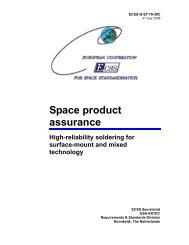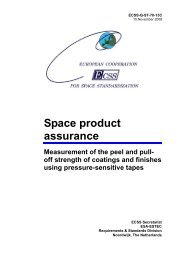DECONTAMINATION OF MMH- AND NTO/MON –PROPELLANT ...
DECONTAMINATION OF MMH- AND NTO/MON –PROPELLANT ...
DECONTAMINATION OF MMH- AND NTO/MON –PROPELLANT ...
Create successful ePaper yourself
Turn your PDF publications into a flip-book with our unique Google optimized e-Paper software.
tank volume with one gas purge can be computed with<br />
the equation 1:<br />
Phigh<br />
− Plow<br />
= Pprop,<br />
⋅ k (1)<br />
P<br />
Pprop, rem<br />
tank<br />
high<br />
Where Pprop,rem = pressure of the removed propellant<br />
[bar], Phigh = high purge pressure (created with nitrogen<br />
pressurisation) [bar], Plow = low purge pressure (after<br />
depressurisation) [bar], Pprop,tank = pressure of the<br />
propellant remaining in the tank [bar] and k = removal<br />
efficiency constant [-].<br />
As long as there is liquid propellant it the tank Pprop,tank<br />
equals to the vapour pressure of the propellant. The<br />
removed mass of propellant can be calculated from the<br />
removed pressure in the tank volume. The residual<br />
propellant mass is then calculated by deducting the<br />
removed propellant masses from the known or<br />
assumed initial residuals.<br />
The formulation of equation 1 is based on the<br />
assumption that the removed propellant vapour is<br />
relative to the ratio of pressure drop in the tank and to a<br />
removal efficiency k. The removal efficiency is<br />
assumed to be constant. In this paper k is derived from<br />
the ROSETTA’s IPA drying curve [4] and equals<br />
k=0.7. The value is also in accordance with the<br />
measurement from the <strong>MMH</strong> tank drying with nitrogen<br />
gas purges of the ESA Artemis spacecraft [5]. It should<br />
be noted that since k has been evaluated based on two<br />
cases only, the model is approximate.<br />
2.3 <strong>MMH</strong> Tank Decontamination with Nitrogen<br />
Gas Purges – Application to ROSETTA<br />
The removal of liquid and gaseous <strong>MMH</strong> from the<br />
ROSETTA propellant tank has been evaluated with<br />
equation 1 with following parameters: high purging<br />
pressure Phigh = 3.5 bar, low purging pressure Plow = 1.5<br />
bar, tank volume V=1.108 m 3 , liquid propellant<br />
residual 0.13dm 3 and temperature T =295K. It was<br />
considered that four gas purges could be done per day.<br />
Figure 1 presents the results computed with equation 1<br />
for modelling propellant pressure in the tank in<br />
function of number of gas purges and time.<br />
According to the computation (Fig.1) the liquid<br />
propellant residual is all in vapour form after three gas<br />
purge cycles and it would take a total of 28 gas purge<br />
cycles to reach a <strong>MMH</strong> concentration of 0.1 ppm [6,<br />
6].<br />
The ROSETTA <strong>MMH</strong> tank was decontaminated with<br />
nitrogen and helium gas purges [8], Fig 1. After 27<br />
nitrogen gas purge cycles the measured <strong>MMH</strong> level<br />
was between 0.5 and 3 ppm, which is well in<br />
accordance with the prediction. It was then decided to<br />
change nitrogen gas to helium gas in order to achieve a<br />
high concentration of helium at the end of<br />
decontamination process. Yet, the measurements made<br />
on samples taken after a total of 28 and 30 gas cycles<br />
were indicating <strong>MMH</strong> concentrations between 4 and<br />
13 ppm, which was confusing. Later it became obvious<br />
that the Dräger tubes that were used to determine the<br />
<strong>MMH</strong> level, gave a higher response with helium than<br />
with nitrogen.<br />
Pressure fraction [ppm]<br />
1.E+05<br />
1.E+04<br />
1.E+03<br />
1.E+02<br />
1.E+01<br />
1.E+00<br />
1.E-01<br />
1.E-02<br />
1st GAS PURGE<br />
Fraction of <strong>MMH</strong> in the nitrogen purging gas:<br />
Predicted and Measured in function of number of gas purges<br />
0 1 2 3<br />
Time [days]<br />
4 5 6 7 8 9<br />
5th GAS PURGE<br />
9th GAS PURGE<br />
Pressure ratio of <strong>MMH</strong> in nitrogen purging gas, 3.5 bar<br />
Pressure ratio of <strong>MMH</strong> in nitrogen purging gas, 1.5 bar<br />
Measured average<br />
13th GAS PURGE<br />
Figure 1: Pressure ratio of <strong>MMH</strong> vapour in nitrogen<br />
purging gas: predicted and measured. Predicted: The<br />
partial pressure ratio of the <strong>MMH</strong> propellant in the<br />
tanks is assumed to be constant during one purge<br />
operation, but since the purging pressure varies<br />
between 1.5 bar and 3.5 bar, the pressure ratio of<br />
<strong>MMH</strong> in the purging gas actually varies: when the<br />
purging pressure is high the ratio of <strong>MMH</strong> vapour<br />
pressure is low. Measured: The “x” signs on the graph<br />
indicate the measured values in ppm in 1 bar, the<br />
yellow triangle is the average of the measured values.<br />
Although the finally measured <strong>MMH</strong> concentrations in<br />
helium gas (2.5, 0.8, 0.8 ppm) were higher than<br />
expected, the <strong>MMH</strong> concentration level was<br />
considered acceptable and the tank was pressurized to<br />
blanket pressure.<br />
17th GAS PURGE<br />
21st GAS PURGE<br />
<br />
29th GAS PURGE<br />
33rd GAS PURGE<br />
37th GAS PURGE<br />
1.E+05<br />
1.E+04<br />
1.E+03<br />
1.E+02<br />
1.E+01<br />
1.E+00<br />
1.E-01<br />
1.E-02
















